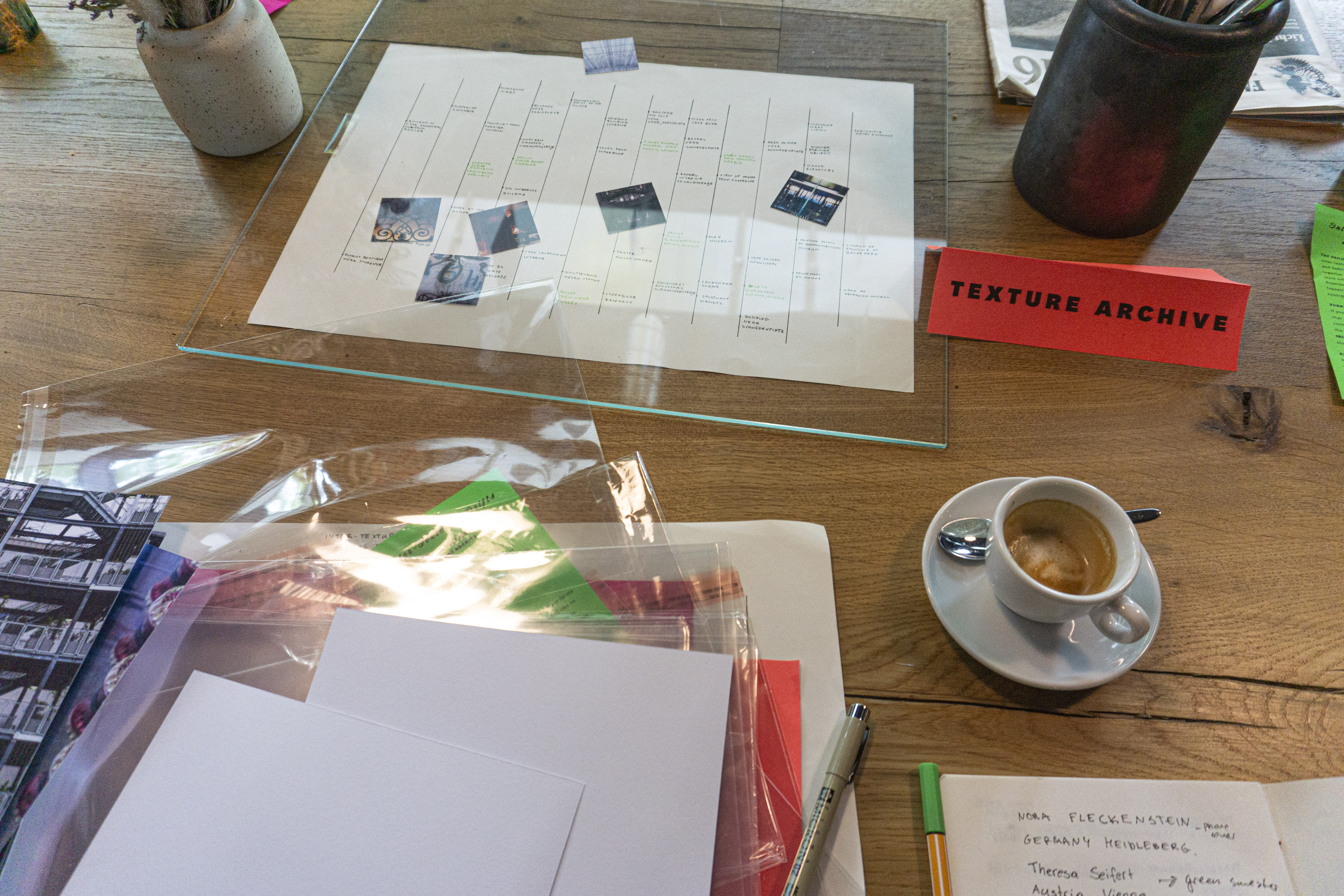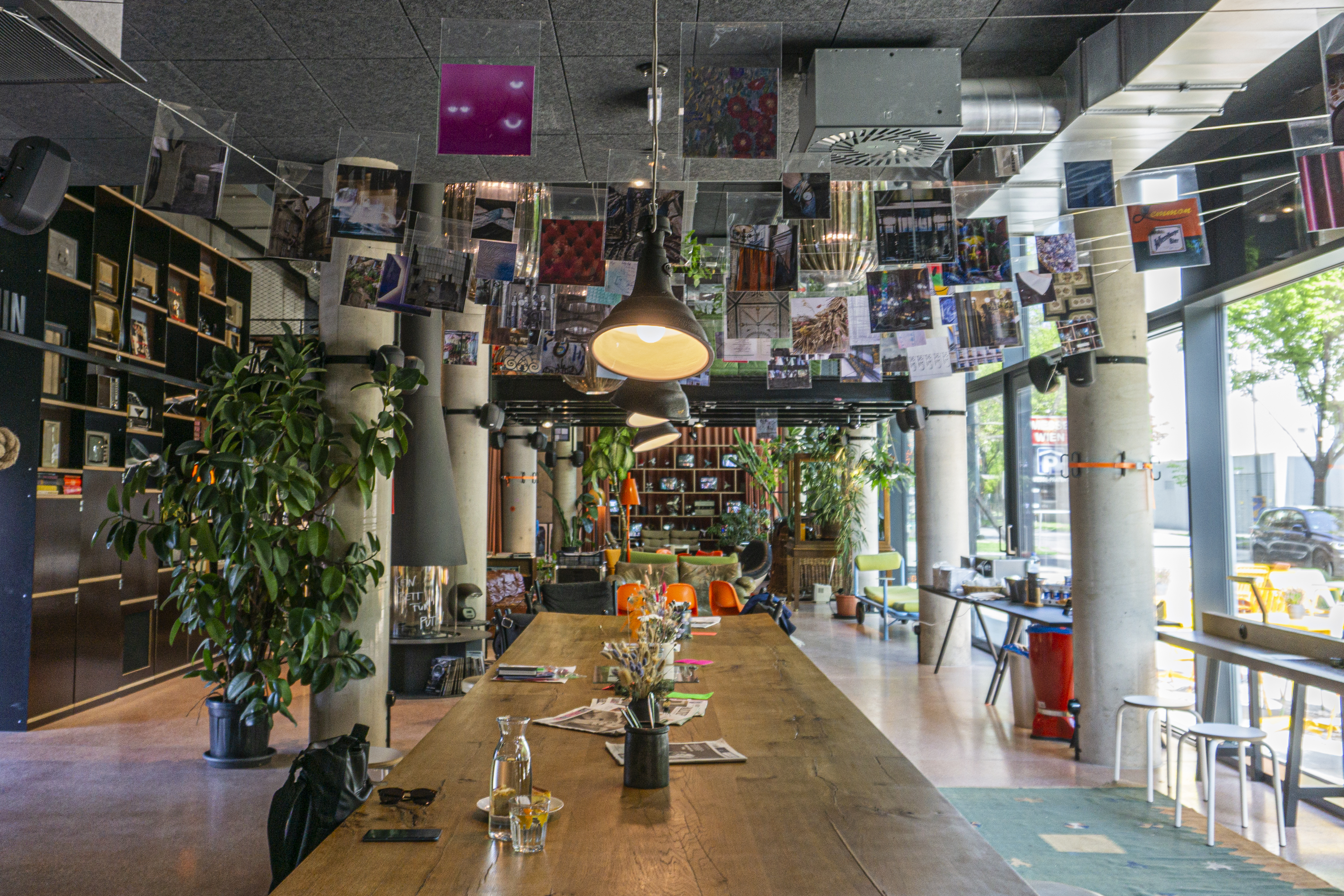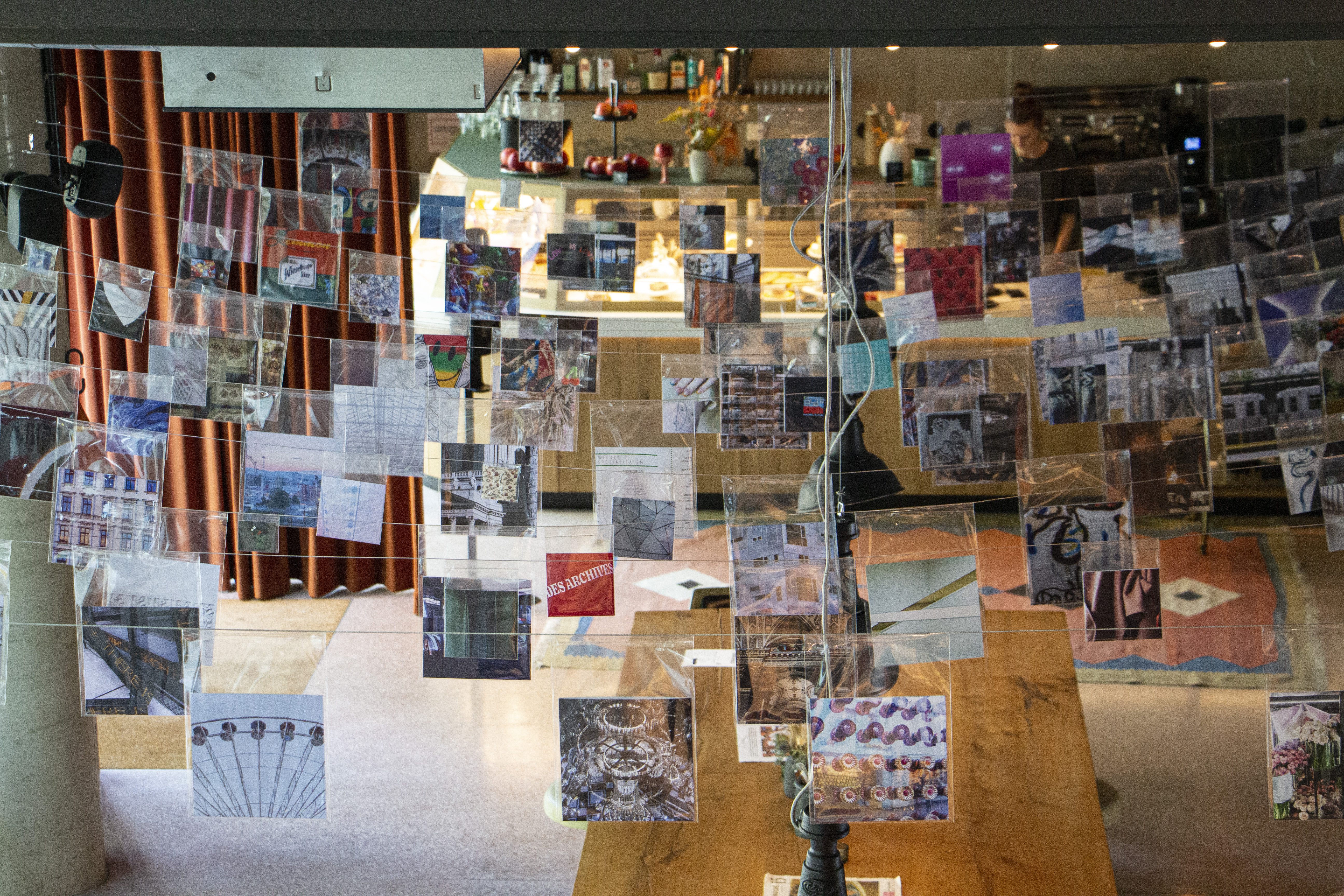
Inter-Textural drifts is an aerial archive that weaves together the more static textures of the city of Vienna, (the metropolitan capital of Austria) with transient textures contributed by individuals moving through the city into a floating tapestry. The project examines and documents the fluid interconnections between the architecture of the city and the aesthetics that visitors bring into it.
It honors some of the fleeting influences that are contributed to the city in ephemeral ways through fashion and documents the general visual landscape of the city through a spatio-temporal-specific collection.
The project combines the idea of the nomadic tapestry with an aerial archive that accumulates over time and develops through engagement with its surroundings. It was completed during a one month residency at the Superbude Vienna Prater Hotel and engaged with the building, hotel visitors, and hotel system.
The archive accumulated during the month of April, and began with urban textures of the city, and then collected contributions from visitors. The artist-archivist collected visitor textures through a series of archival sessions/“performances” at the common table under the installation; curating, photographing, and recording textures of visitors’ clothing in the lobby and cafe area. The archive changed everyday and prompted new conversations and return visits through its development — the process of creating interconnections between the textures also created in-the-world interactive interconnections between people and places.
The sources of the textures are indicated on an abstract map on the table under the installation.
It honors some of the fleeting influences that are contributed to the city in ephemeral ways through fashion and documents the general visual landscape of the city through a spatio-temporal-specific collection.
The project combines the idea of the nomadic tapestry with an aerial archive that accumulates over time and develops through engagement with its surroundings. It was completed during a one month residency at the Superbude Vienna Prater Hotel and engaged with the building, hotel visitors, and hotel system.
The archive accumulated during the month of April, and began with urban textures of the city, and then collected contributions from visitors. The artist-archivist collected visitor textures through a series of archival sessions/“performances” at the common table under the installation; curating, photographing, and recording textures of visitors’ clothing in the lobby and cafe area. The archive changed everyday and prompted new conversations and return visits through its development — the process of creating interconnections between the textures also created in-the-world interactive interconnections between people and places.
The sources of the textures are indicated on an abstract map on the table under the installation.
Tapestry as medium:
The tapestry is historically almost a literary form. It is a malleable and transportable recording of history, values, mythologies. Tapestries in different forms (such as quilts or patchworks) also collect souvenir traces from places that they have traveled through and cultures that they have encountered. Tapestries can cover moving caravans, or adorn the walls of palaces and estates. They are thus also in the ambiguous category of writing, archive, decoration, and object of utility.
As inspiration for this project, I combine the concept of the nomadic tapestry with the idea of the aerial archive that records textures from a broader sphere (architecture in the city of Vienna) with a more local sphere (visitors in the Superbude Hotel lobby and Brenner coffee shop). “Visitors” is deliberately (and somewhat subversively) meant in a broad sense and includes hotel guests from abroad, local cafe guests, and people who work at the hotel.
This combination of concepts was a dispositif that I was using through which to observe the idea of transience. Nomadism and travel is often seen as the ultimate freedom, but at a time when people are forced, encouraged, or expected to travel, they are also forced into further restrictions, regulations, and forms of control. So wether people are moving to flee from something, to go towards something, or because they need to be continuously on the move (either to escape something, to collect experience, or because their positions are not permanent and so they must go towards the next source of survival — in both the literal sense of survival and neoliberal sense of professional development), they become more integrated into neoliberal forms of data-collection, digital surveillance, biopolitical interrogation, and legal examination.
I use the typically apolitical realm of aesthetics, focusing on textures, to create an alternative study of the contributions that these fleeting interactions between people moving at different paces through a transitory location bring to the more “static” and solidified visual landscape of the city, with individual contributions treated in an almost equal way as the samples of urban aesthetics. What appears to be a merely stylistic collage also functions as a recording of transient influences that were momentarily in that location, connected to well known city spaces, offering a sensory “history” of spatial experience from that segment of time (the month of April 2022). Without direct narration, these textures decorate with fragments of the familiar, the exotic, the novel, the historical, and at the same time passively offer glimpses of social conditions, urban experiences, cultural norms, political situations, and global ideologies.
The study becomes a decoration, a guide, and an archive of a time in the the space’s recent history. Descriptions and contributor credits (including name and location) are mapped below the work, and can serve as a sensory, textural guide to the city of Vienna.
The tapestry is historically almost a literary form. It is a malleable and transportable recording of history, values, mythologies. Tapestries in different forms (such as quilts or patchworks) also collect souvenir traces from places that they have traveled through and cultures that they have encountered. Tapestries can cover moving caravans, or adorn the walls of palaces and estates. They are thus also in the ambiguous category of writing, archive, decoration, and object of utility.
As inspiration for this project, I combine the concept of the nomadic tapestry with the idea of the aerial archive that records textures from a broader sphere (architecture in the city of Vienna) with a more local sphere (visitors in the Superbude Hotel lobby and Brenner coffee shop). “Visitors” is deliberately (and somewhat subversively) meant in a broad sense and includes hotel guests from abroad, local cafe guests, and people who work at the hotel.
This combination of concepts was a dispositif that I was using through which to observe the idea of transience. Nomadism and travel is often seen as the ultimate freedom, but at a time when people are forced, encouraged, or expected to travel, they are also forced into further restrictions, regulations, and forms of control. So wether people are moving to flee from something, to go towards something, or because they need to be continuously on the move (either to escape something, to collect experience, or because their positions are not permanent and so they must go towards the next source of survival — in both the literal sense of survival and neoliberal sense of professional development), they become more integrated into neoliberal forms of data-collection, digital surveillance, biopolitical interrogation, and legal examination.
I use the typically apolitical realm of aesthetics, focusing on textures, to create an alternative study of the contributions that these fleeting interactions between people moving at different paces through a transitory location bring to the more “static” and solidified visual landscape of the city, with individual contributions treated in an almost equal way as the samples of urban aesthetics. What appears to be a merely stylistic collage also functions as a recording of transient influences that were momentarily in that location, connected to well known city spaces, offering a sensory “history” of spatial experience from that segment of time (the month of April 2022). Without direct narration, these textures decorate with fragments of the familiar, the exotic, the novel, the historical, and at the same time passively offer glimpses of social conditions, urban experiences, cultural norms, political situations, and global ideologies.
The study becomes a decoration, a guide, and an archive of a time in the the space’s recent history. Descriptions and contributor credits (including name and location) are mapped below the work, and can serve as a sensory, textural guide to the city of Vienna.
The bespoke work is situated in the Superbude Vienna Prater hotel and Brenner coffee shop as a meeting point of locals and visitors of the city, going through the space at different paces, for different durations, for different purposes, and within different notions of “residing” there from which to draw from.
The space was a home, safe haven, workplace, event venue, cultural center, and meeting point — an intersection of tourists and temporary visitors, continuous visitors (e.g. frequent returning guests for work), refugees, students who frequent the cafe to study, professionals who use the common lobby as a meeting point, employees who either “dwell” there during the work hours/weekdays, employees who populate the place at night and on weekends, creators and publications who use the space for different projects, musicians and audience during concerts, locals who use the hotel as a retreat (there are some purpose-specific rooms, e.g. a movie room with a theater, a book room for studies, a mini hotel within the hotel for the influencer set), and the artist in residence (myself) who lived the hotel for a month and created artistic work within its structures.
Thus, this site becomes an important point from which to sample various aesthetic influences and capture various social phenomena through this stylistic lens.
The space was a home, safe haven, workplace, event venue, cultural center, and meeting point — an intersection of tourists and temporary visitors, continuous visitors (e.g. frequent returning guests for work), refugees, students who frequent the cafe to study, professionals who use the common lobby as a meeting point, employees who either “dwell” there during the work hours/weekdays, employees who populate the place at night and on weekends, creators and publications who use the space for different projects, musicians and audience during concerts, locals who use the hotel as a retreat (there are some purpose-specific rooms, e.g. a movie room with a theater, a book room for studies, a mini hotel within the hotel for the influencer set), and the artist in residence (myself) who lived the hotel for a month and created artistic work within its structures.
Thus, this site becomes an important point from which to sample various aesthetic influences and capture various social phenomena through this stylistic lens.

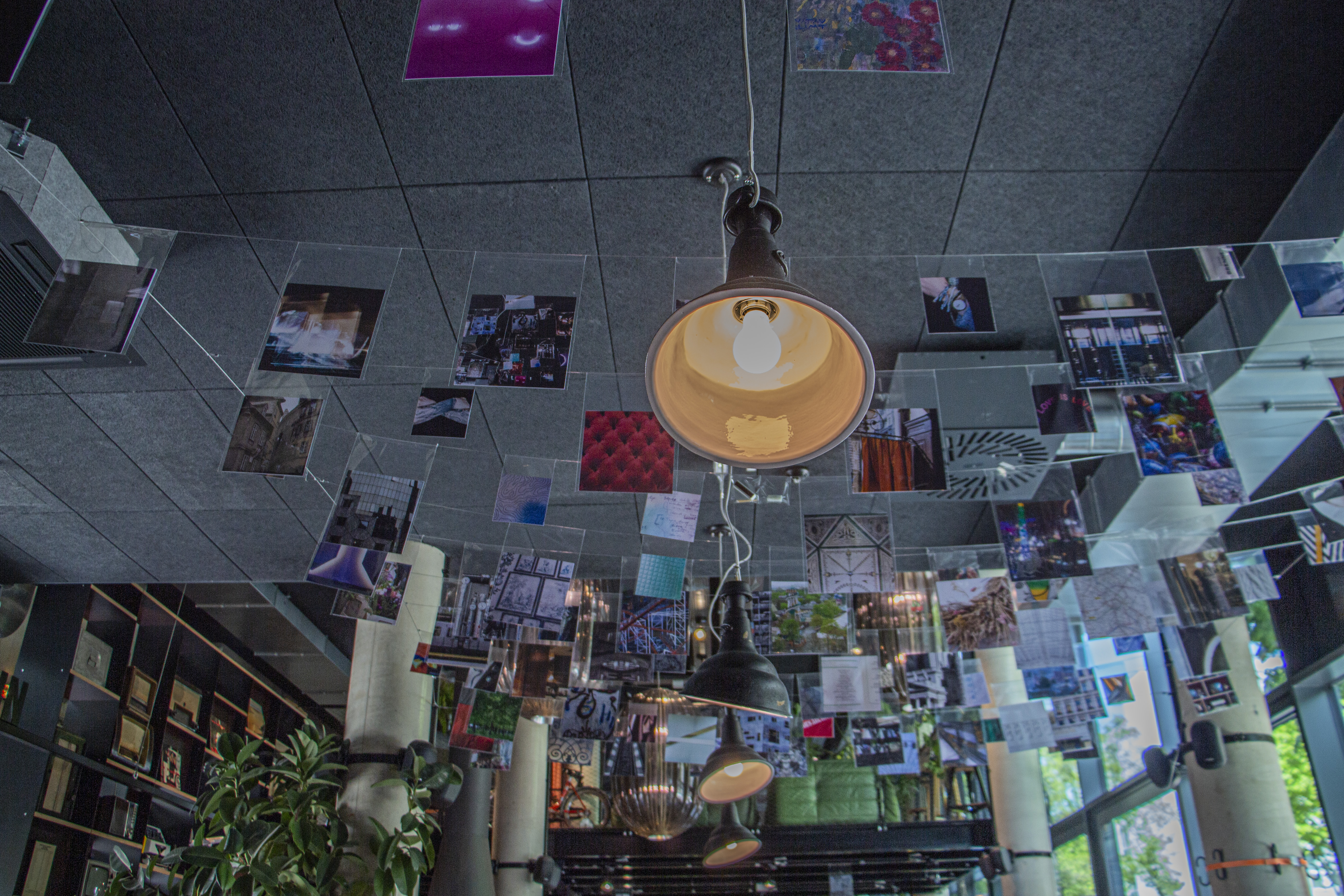


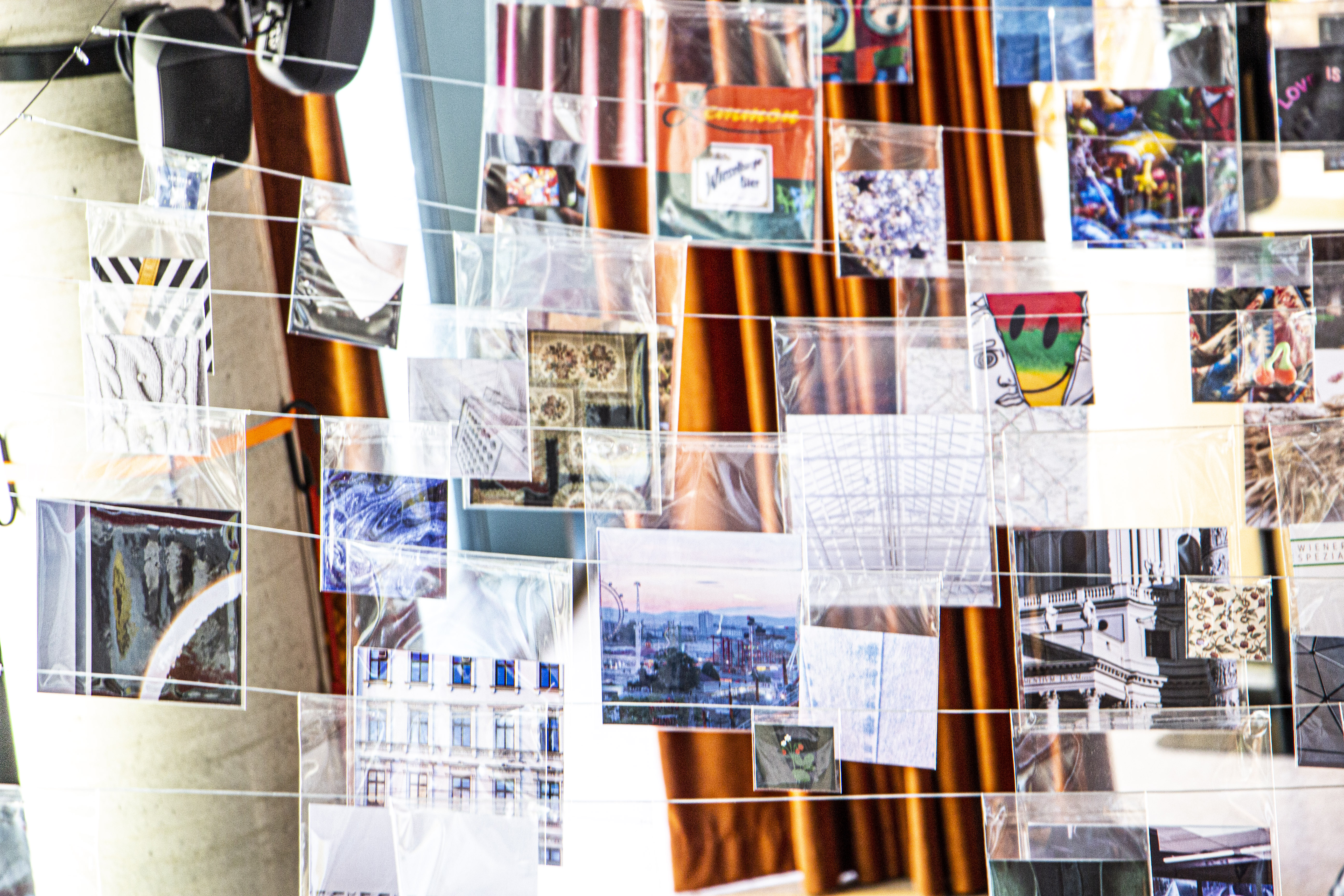
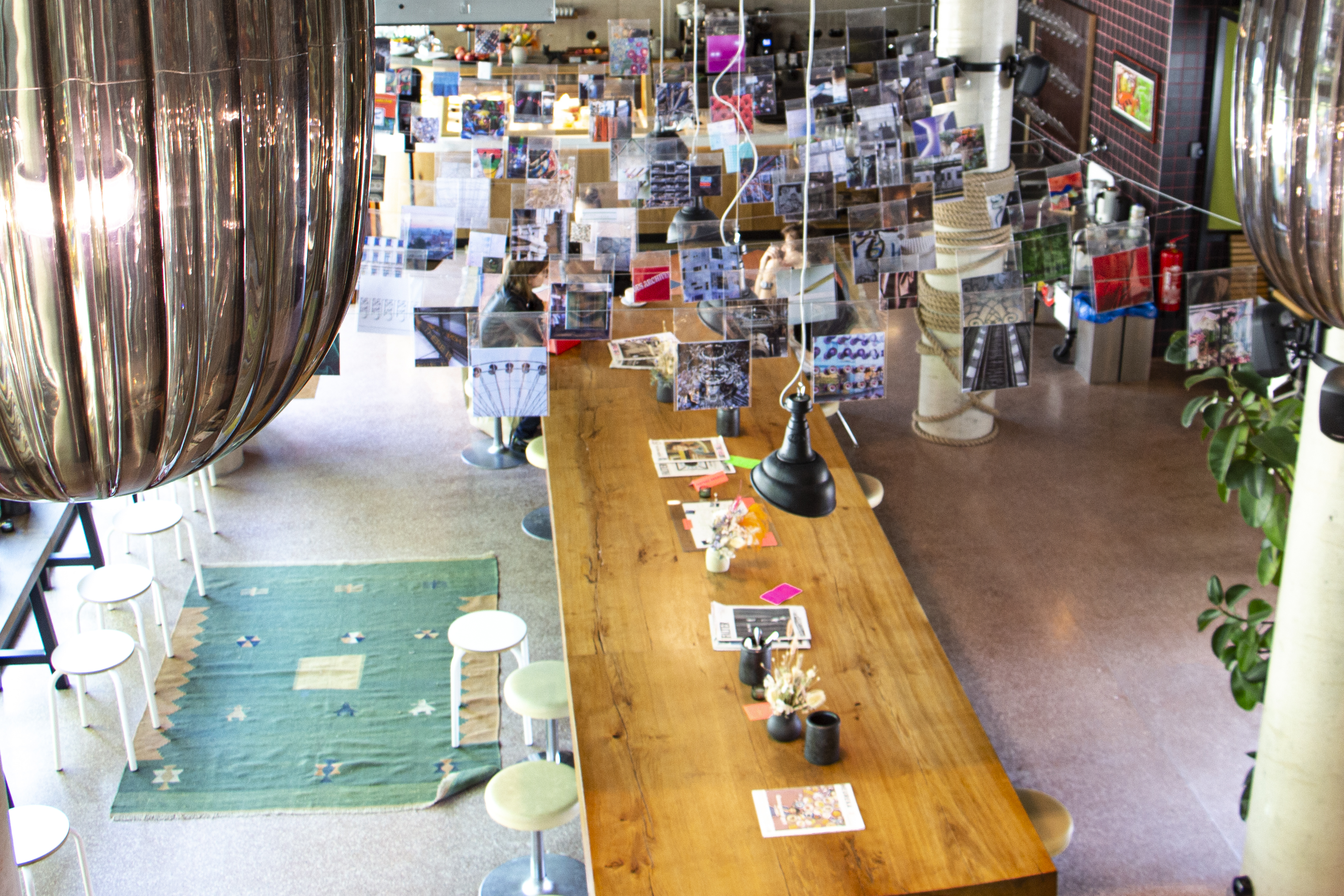
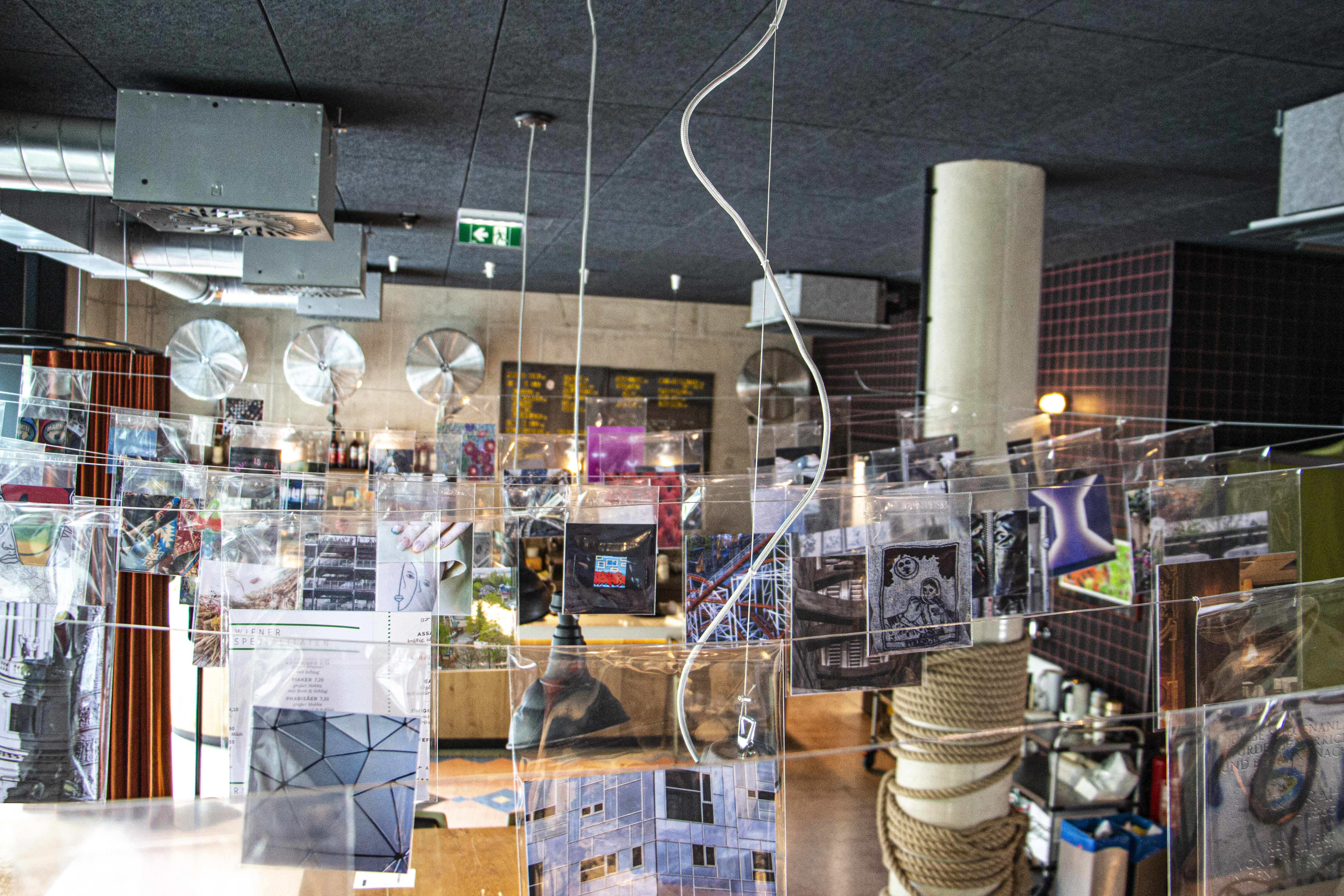
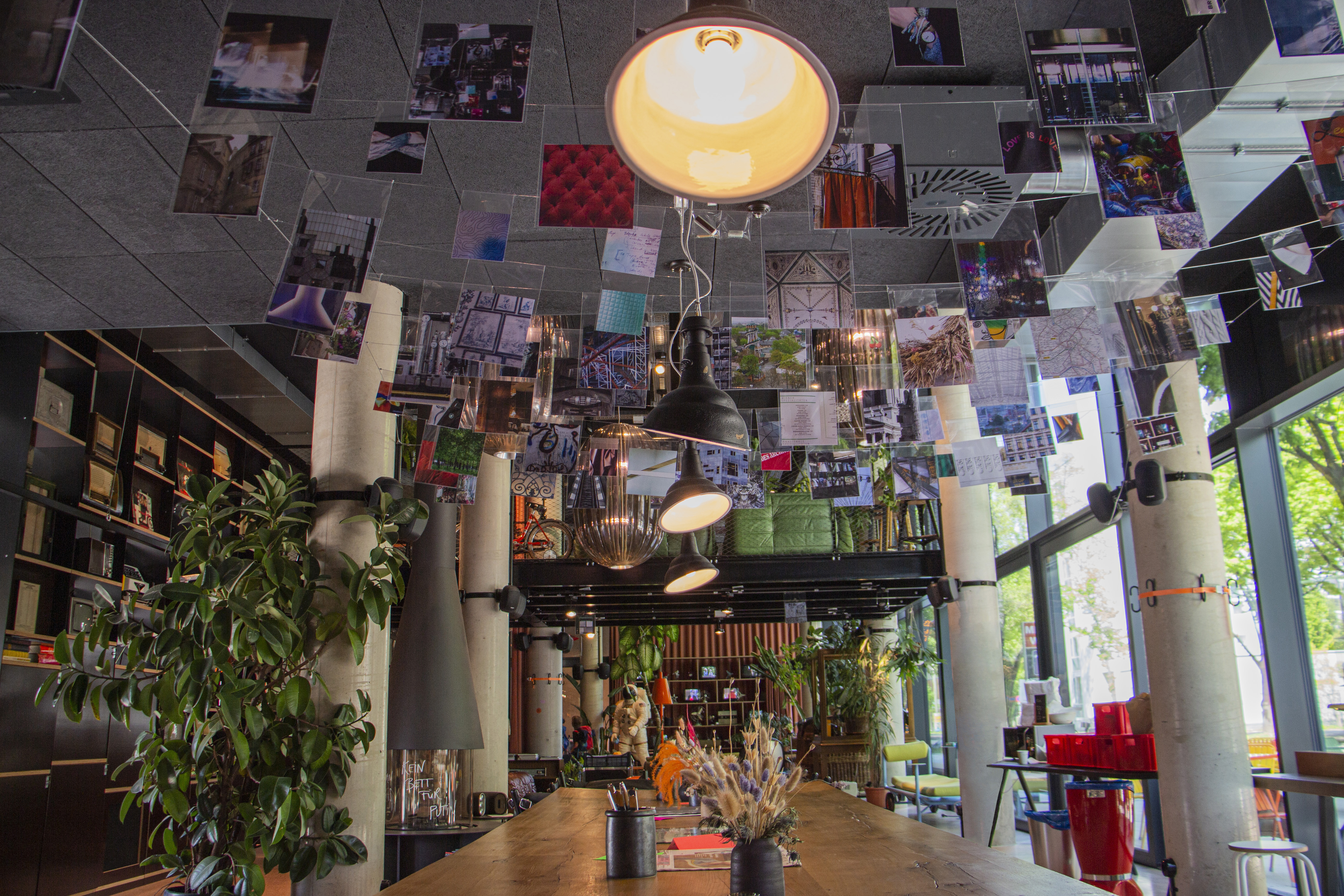
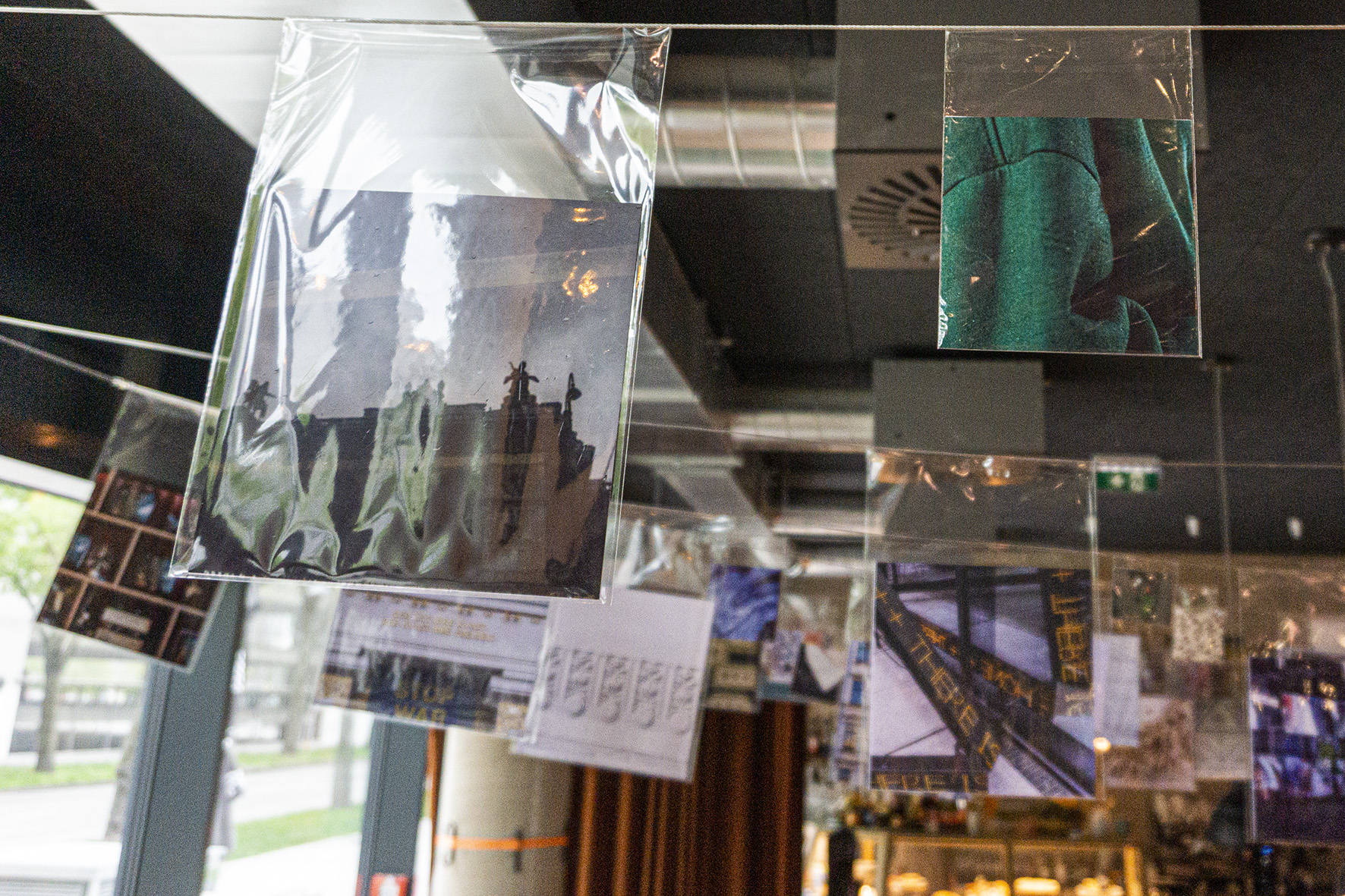
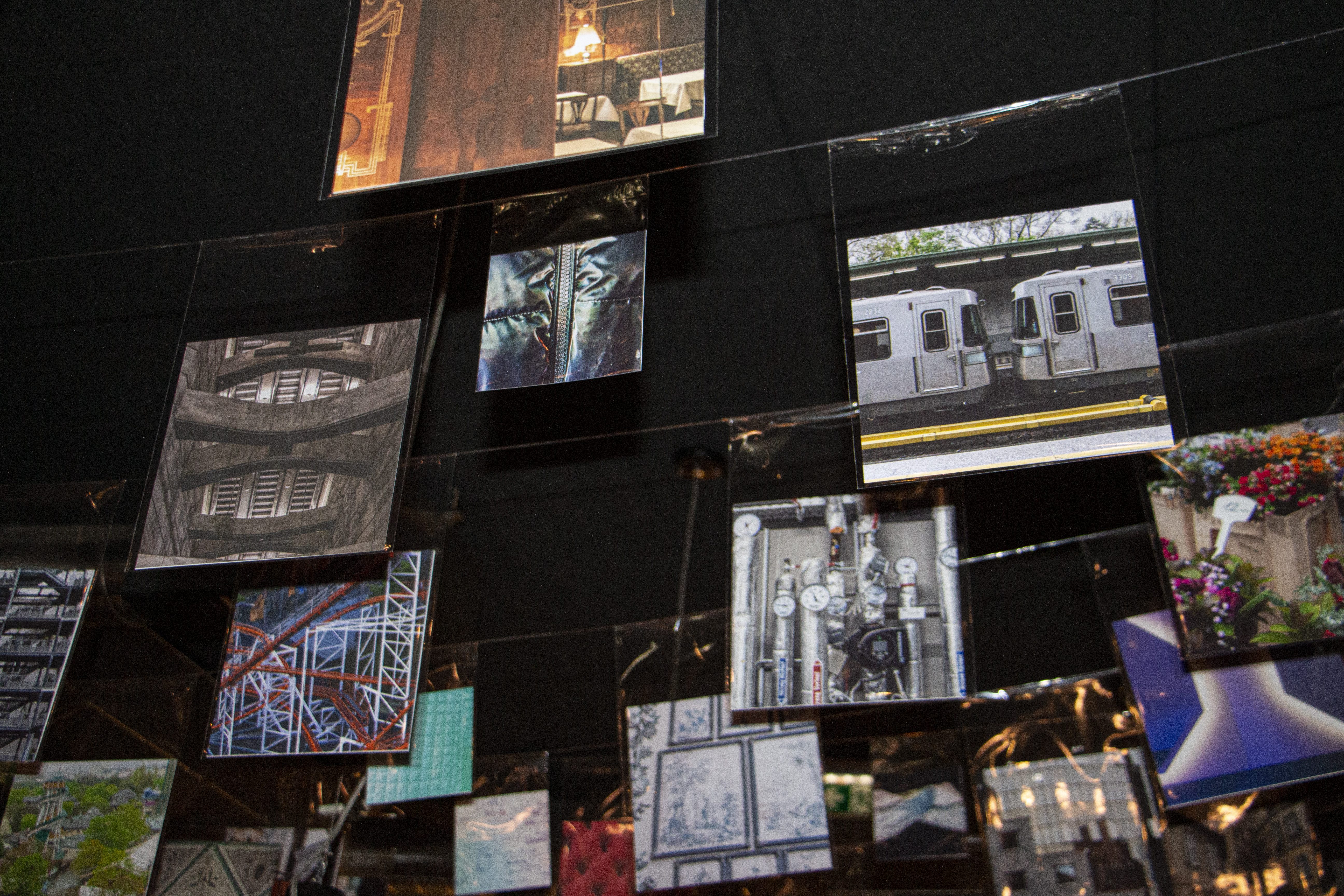



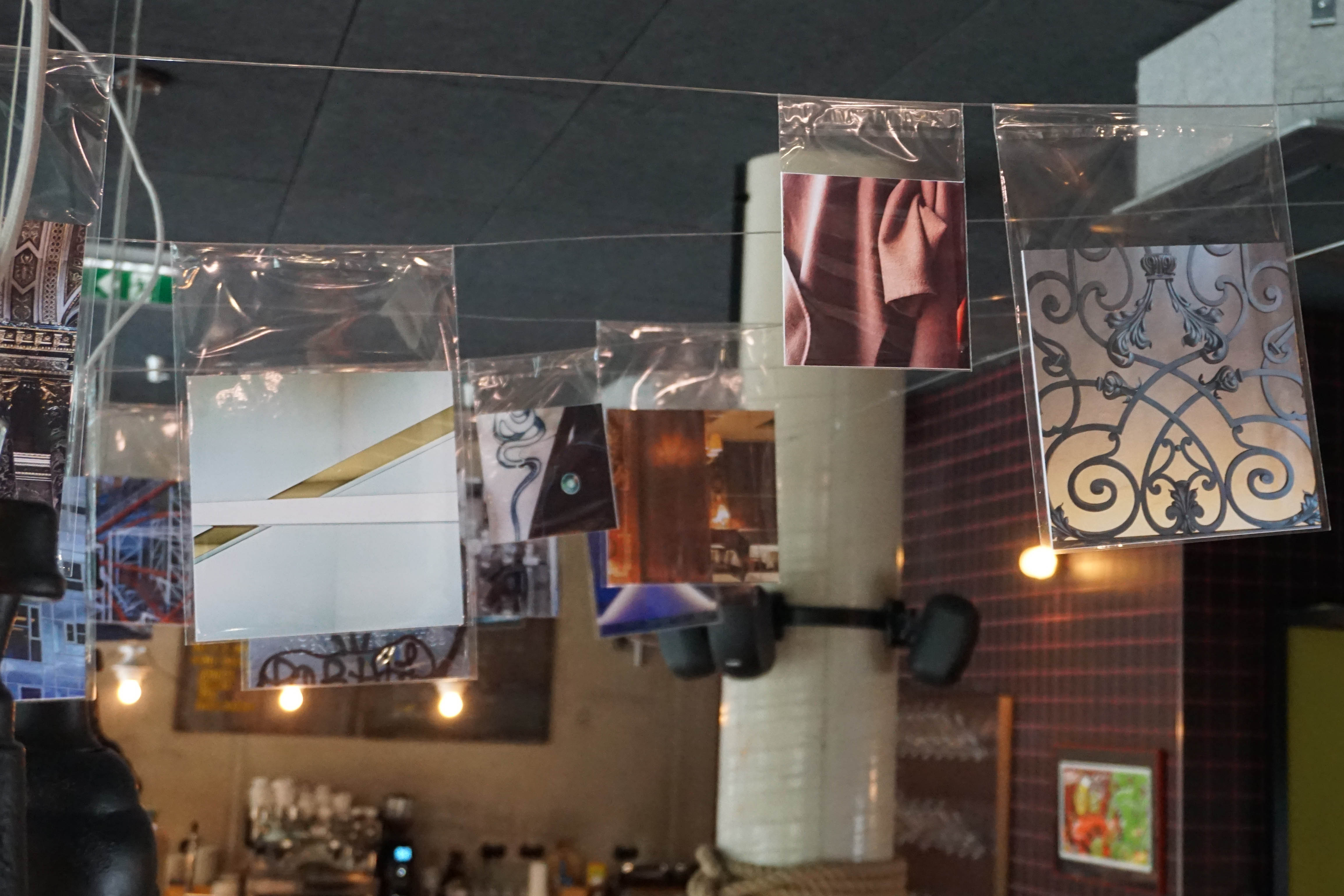
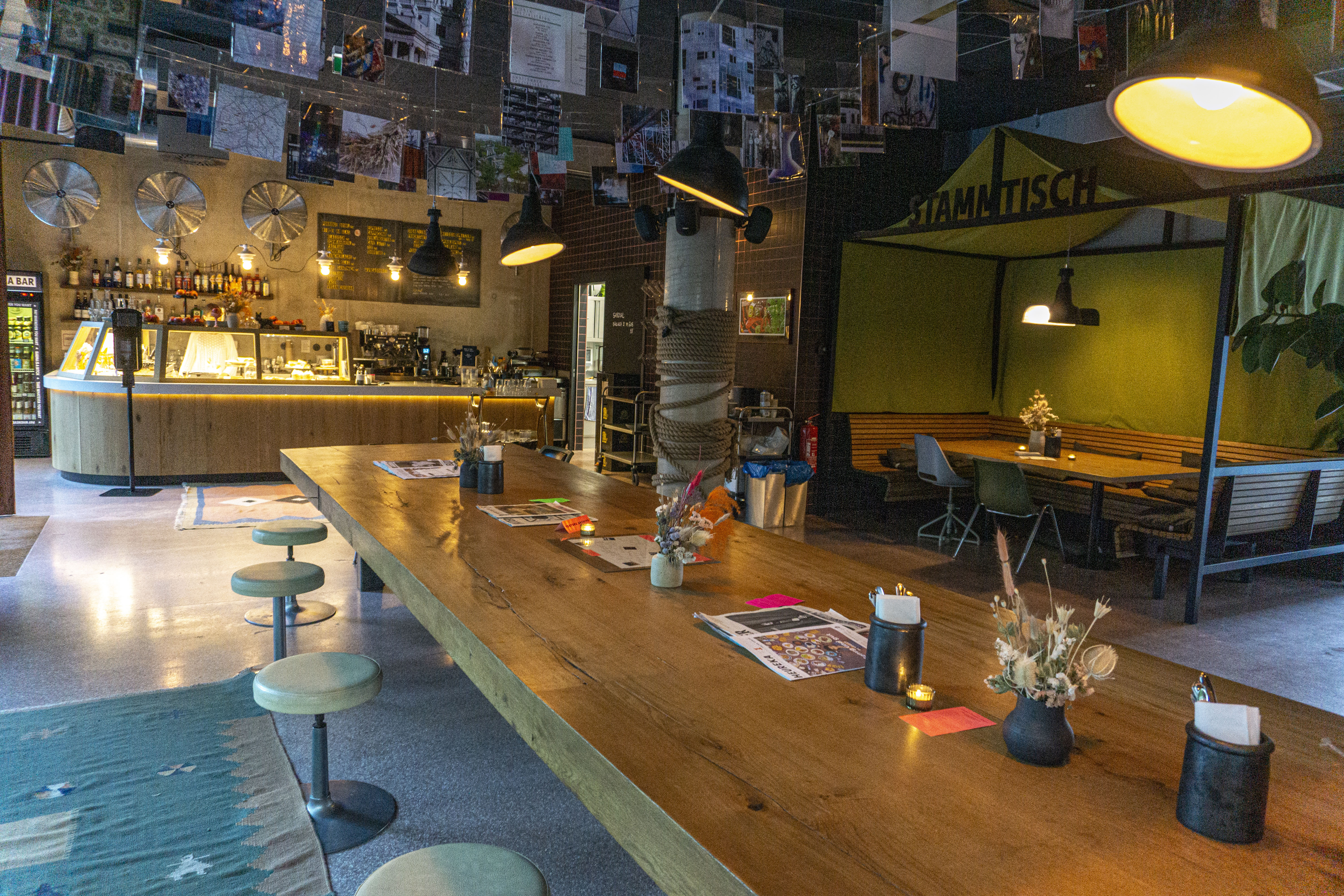



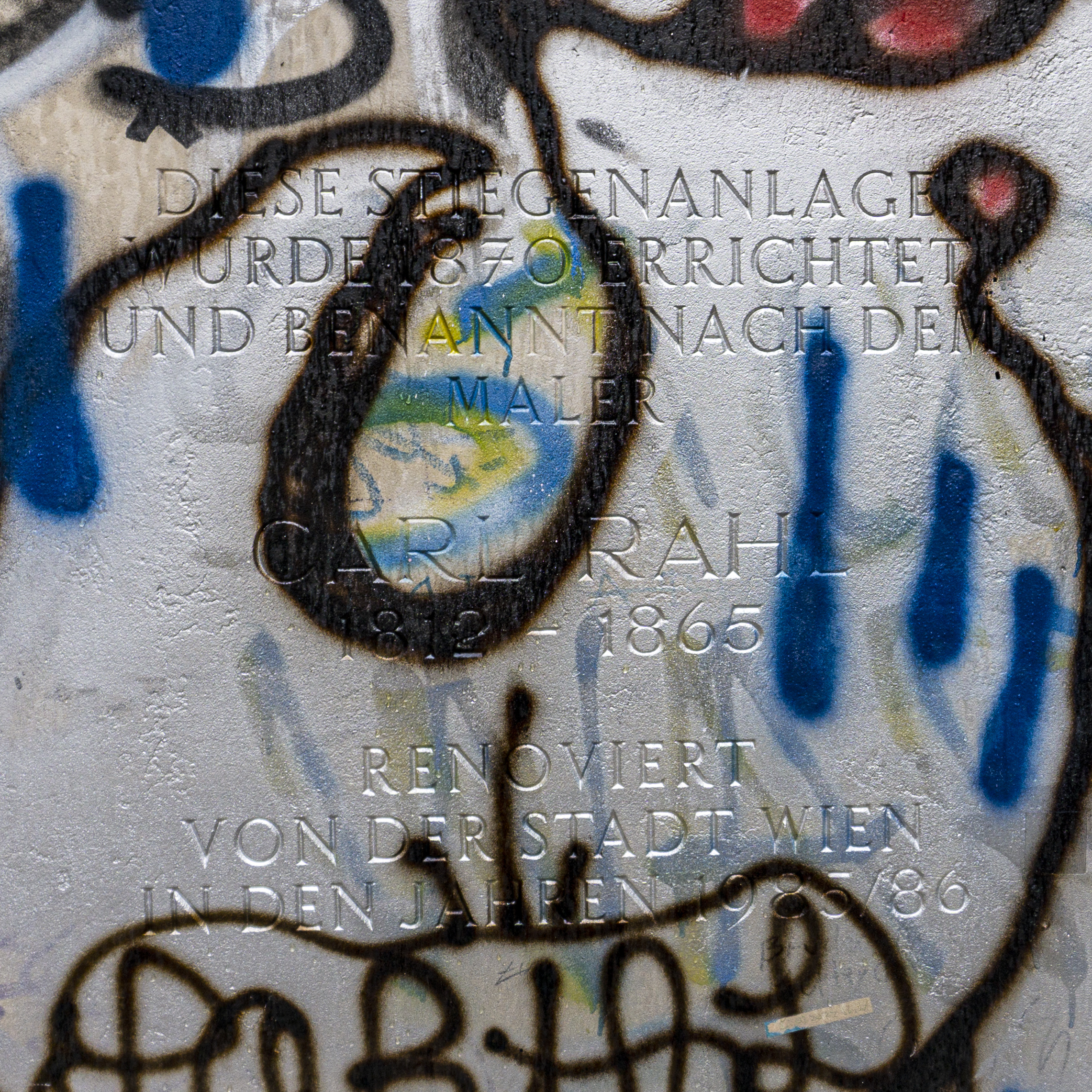
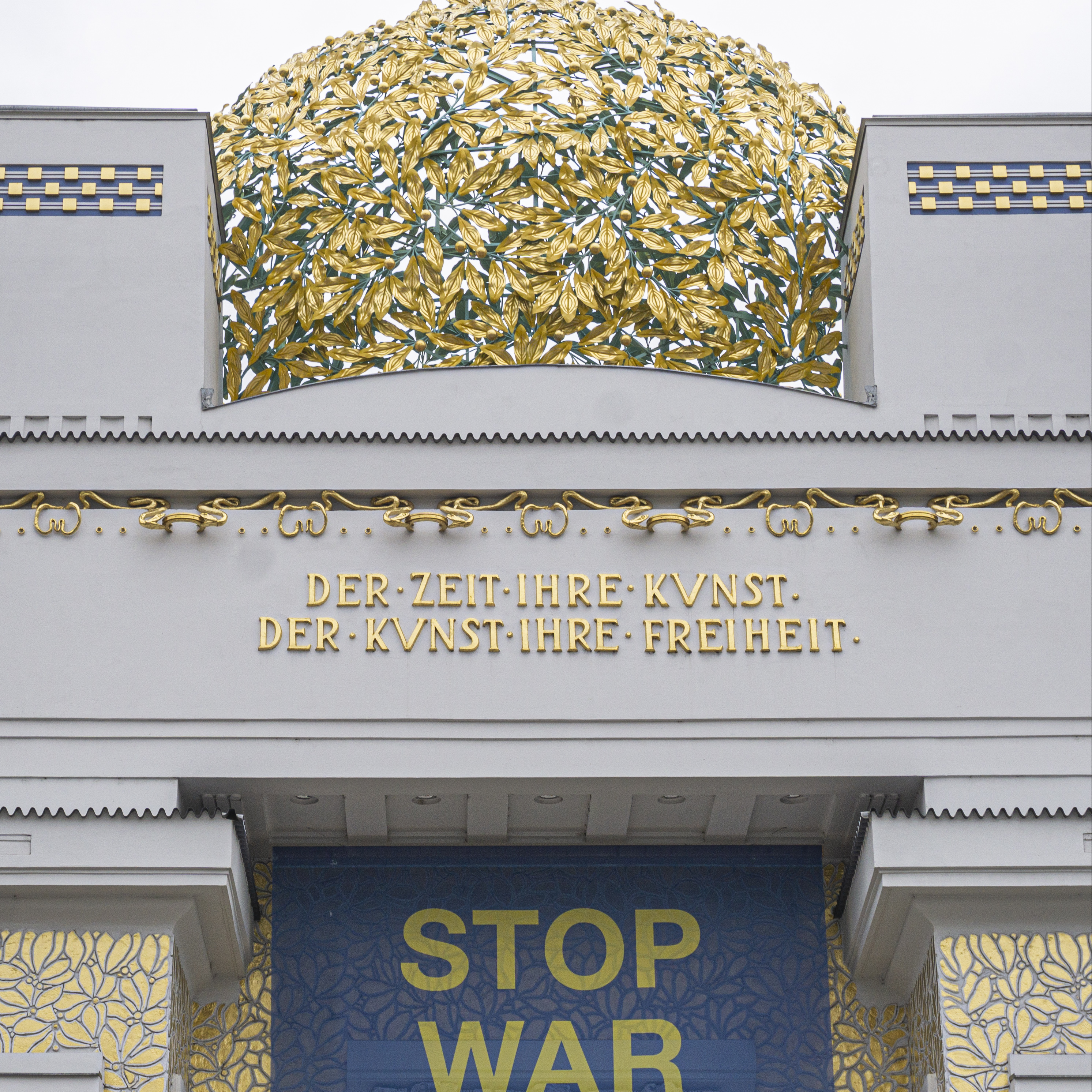
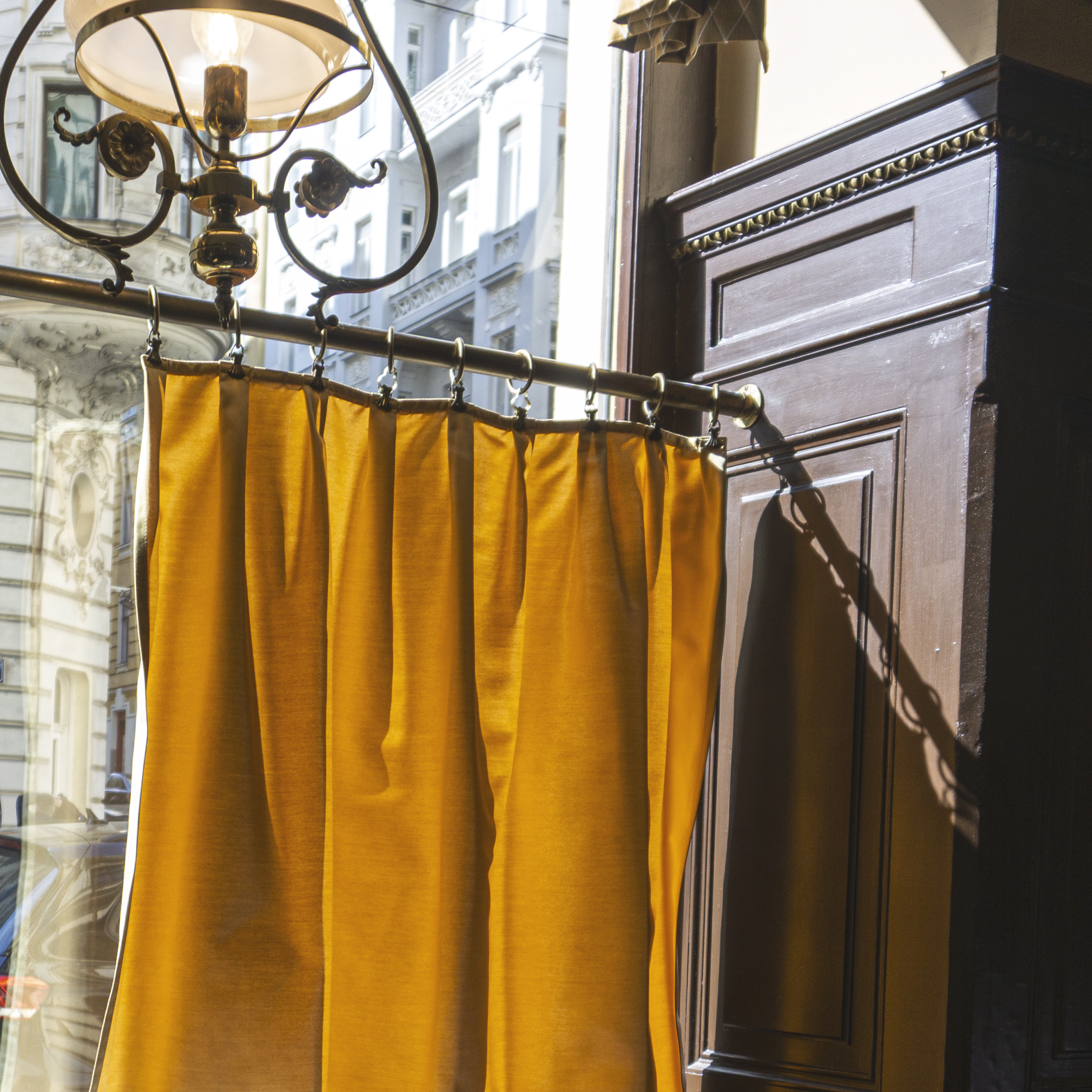


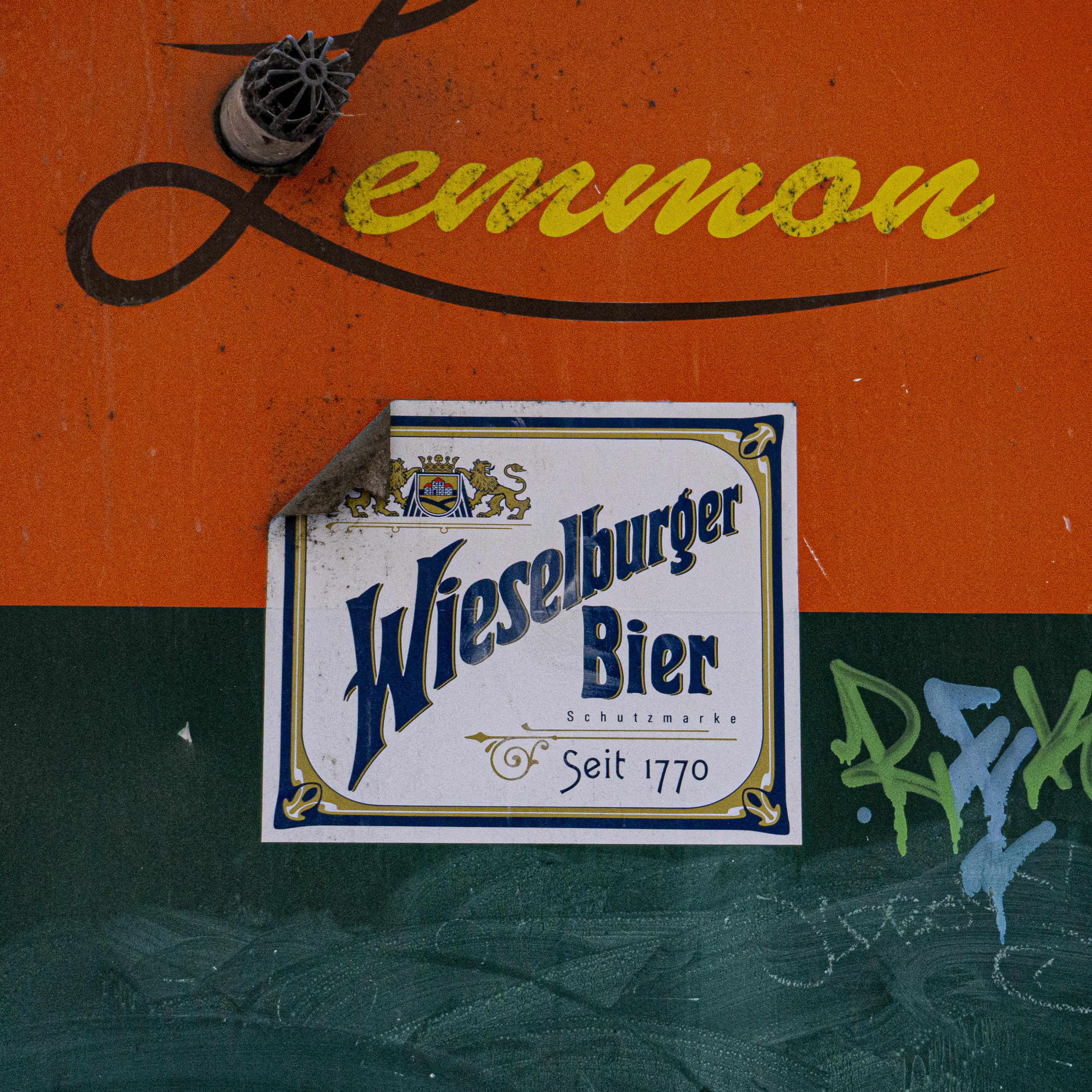



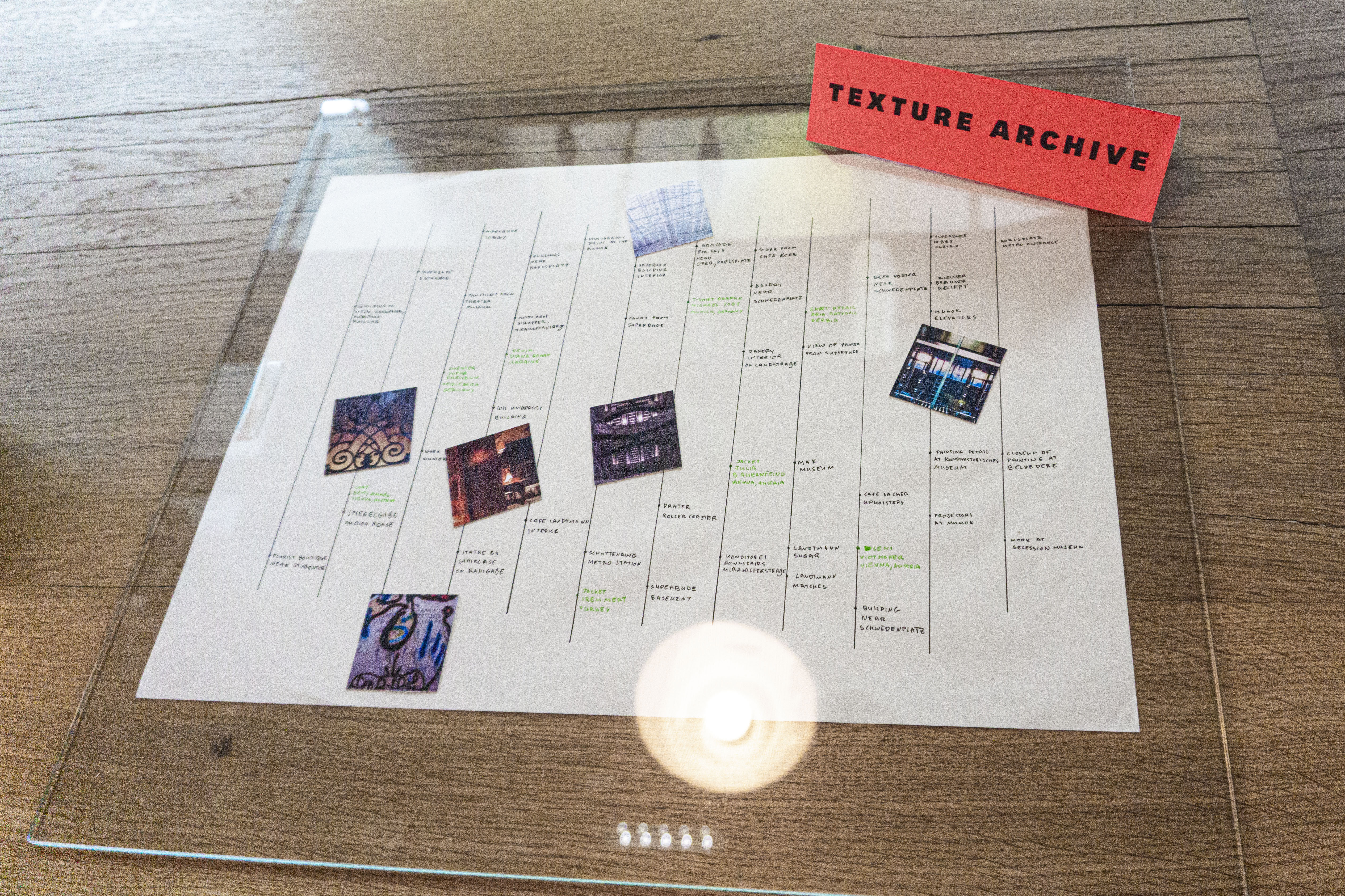


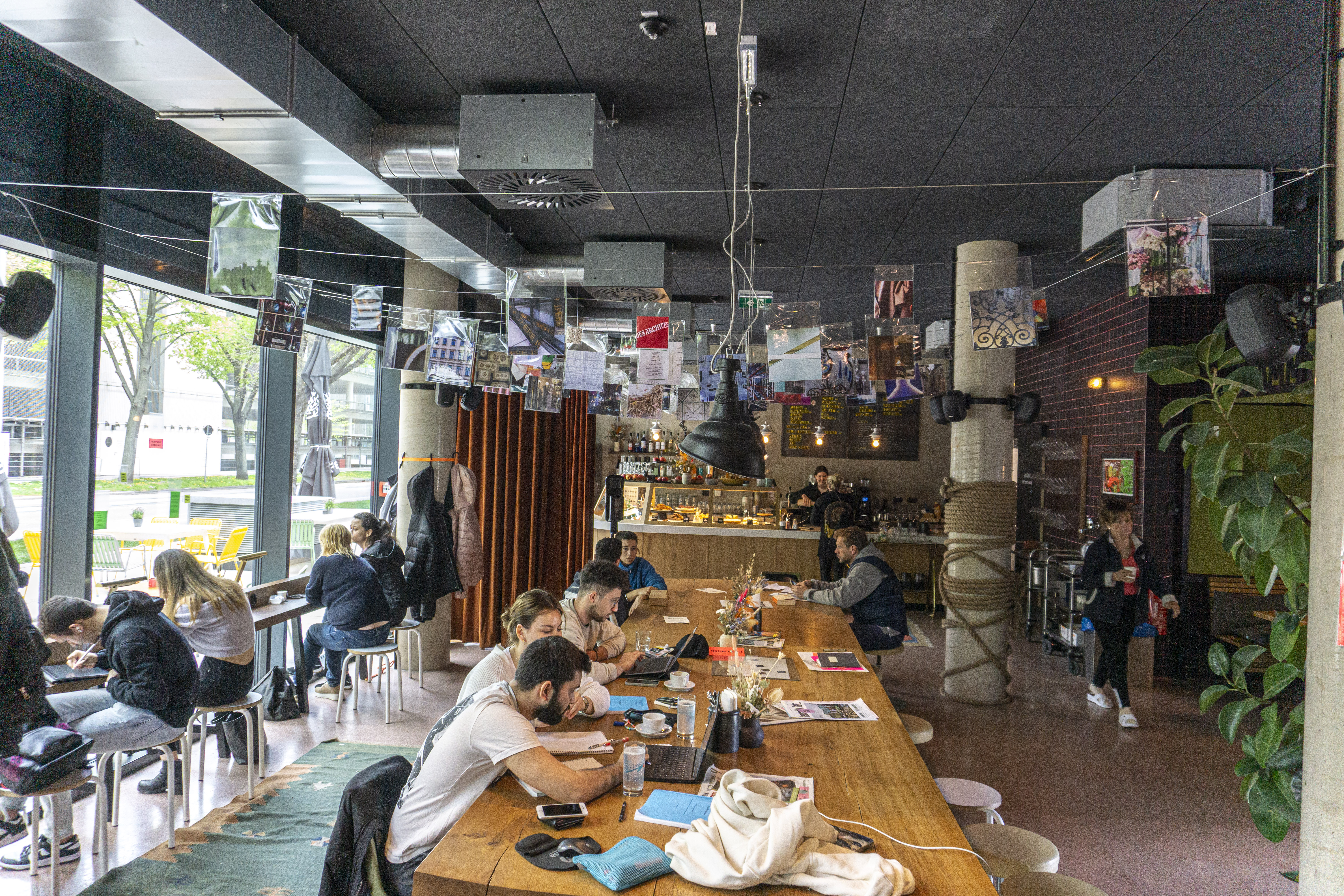
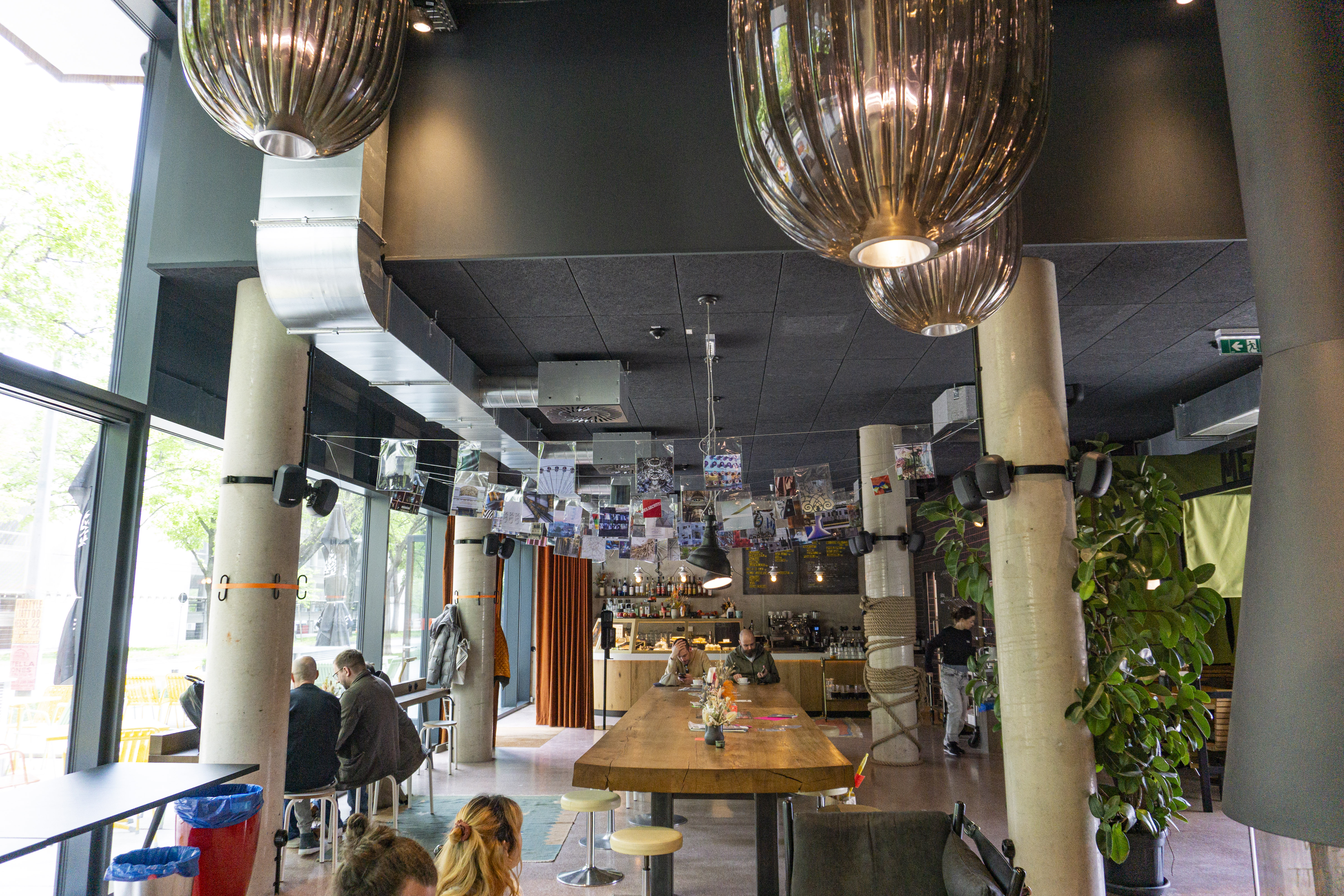
The archive acculmulated throughout the month of April, with new additions every day.
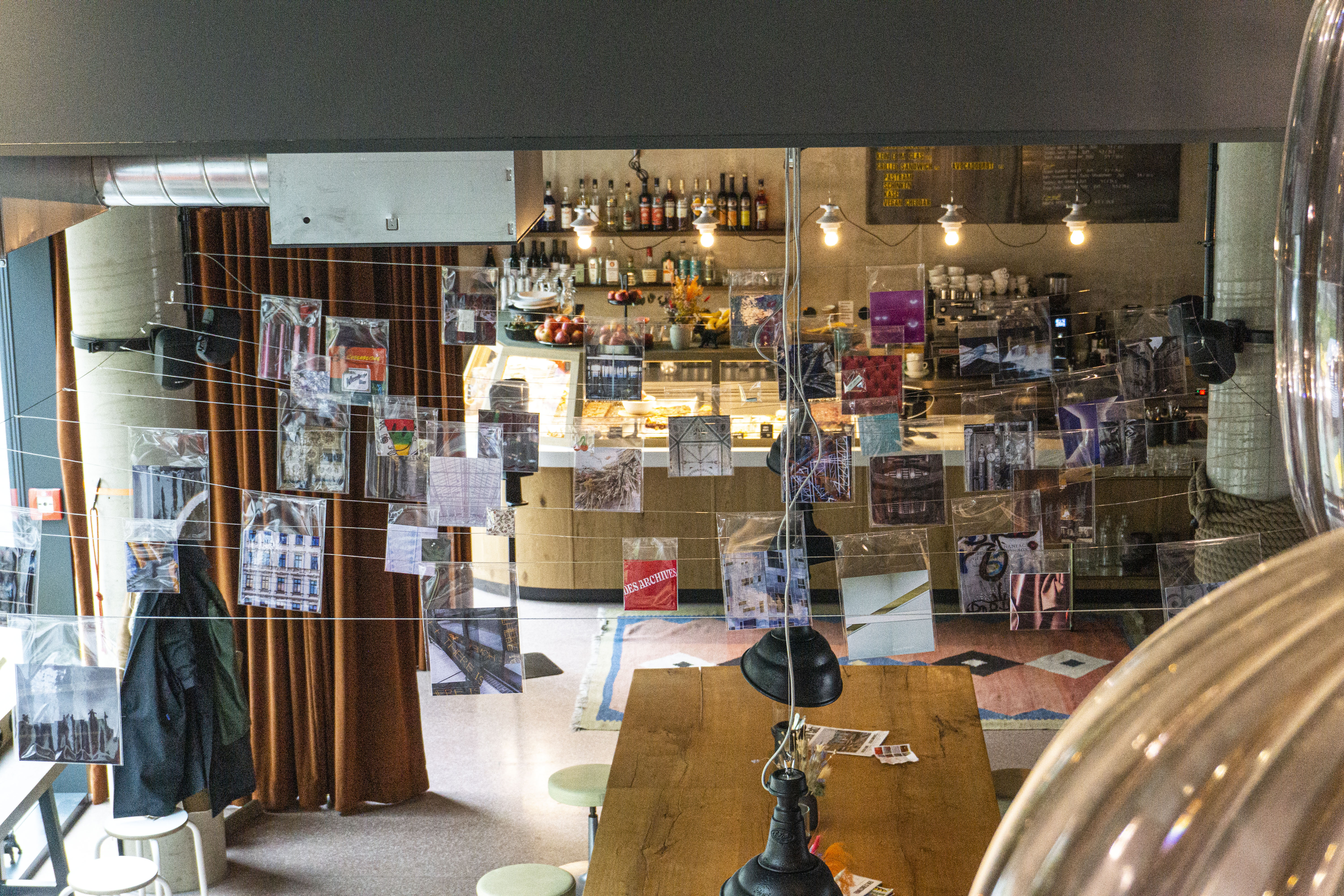

process:





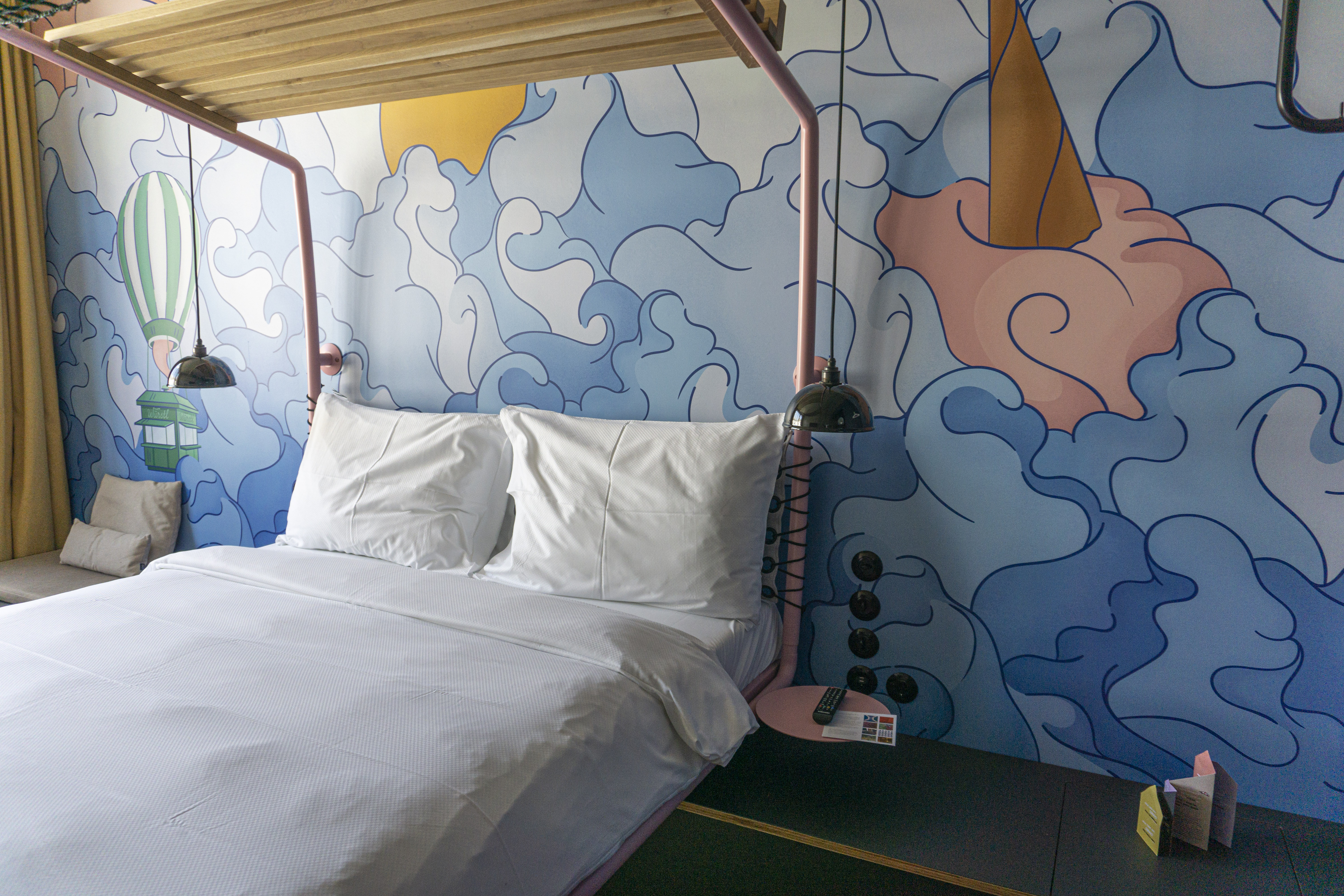


Background images: Building in Stephansplatz, Karlskirche, Reflection in Karlsplatz Station, Top layer of Images from visitors: Bracelets (Annika F. from Frankfurt), backpack (Andrea R. from Linz), jacket drawing (Vera V. from Ukraine). Full names of contributors listed on map.

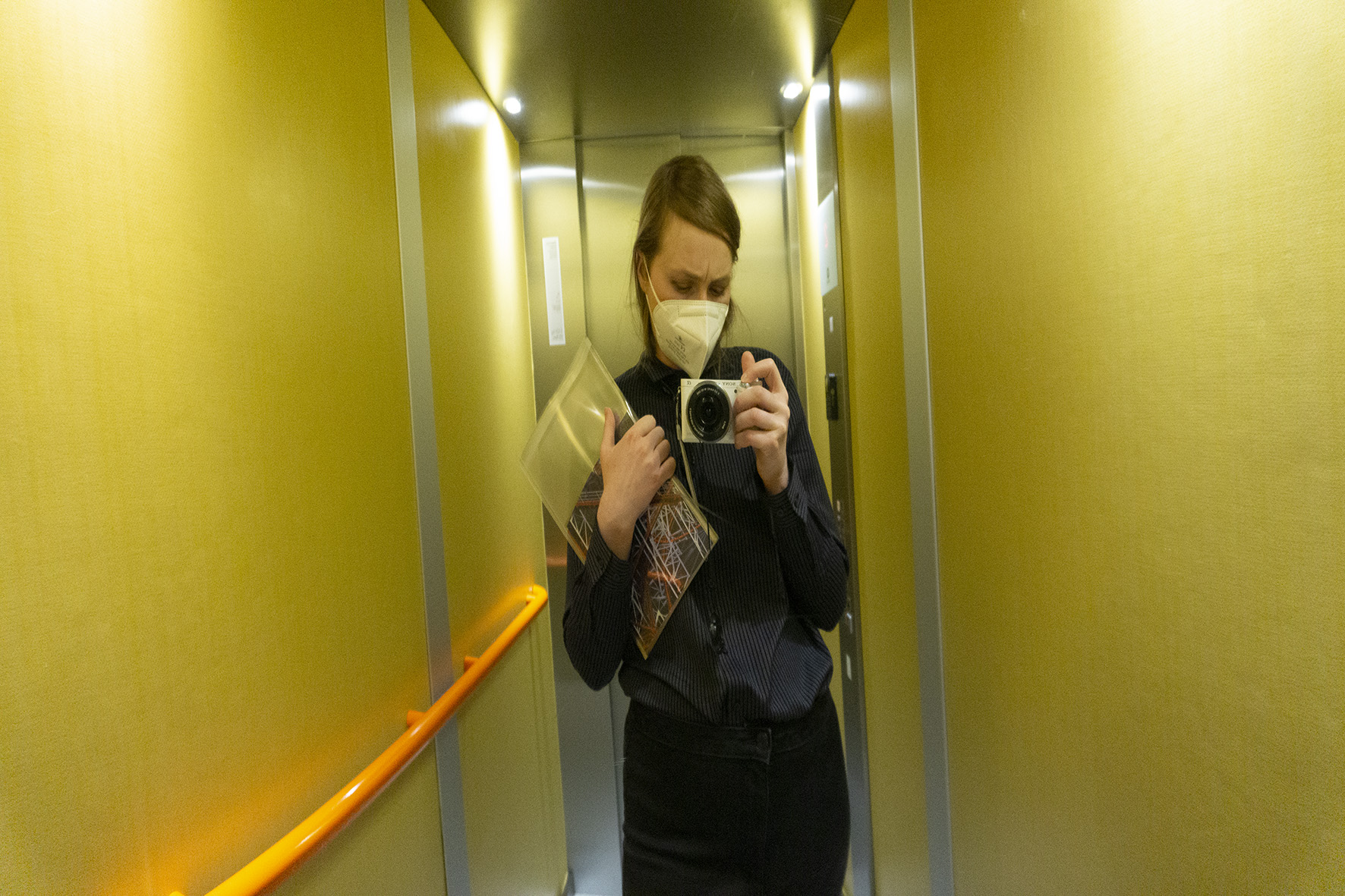
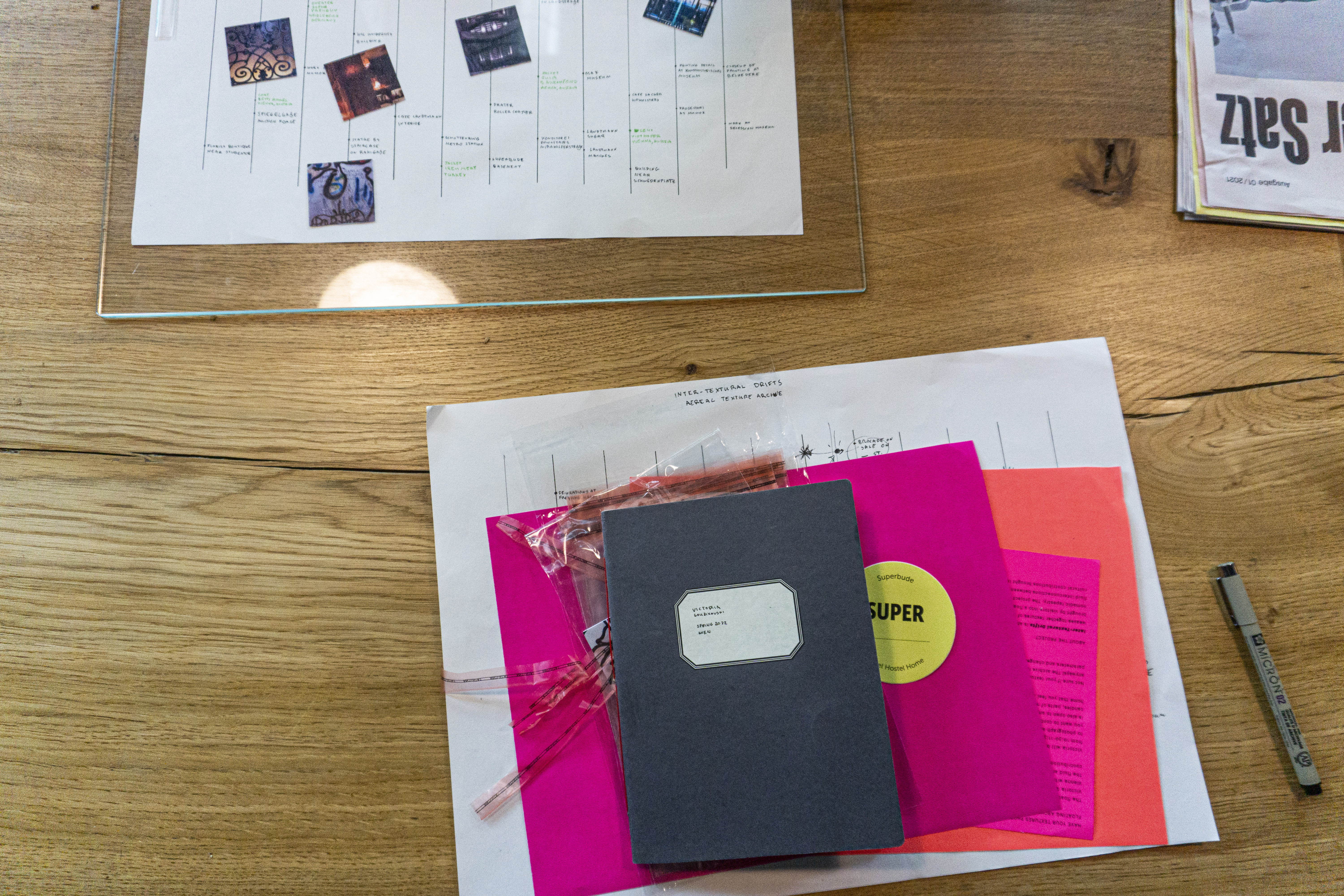


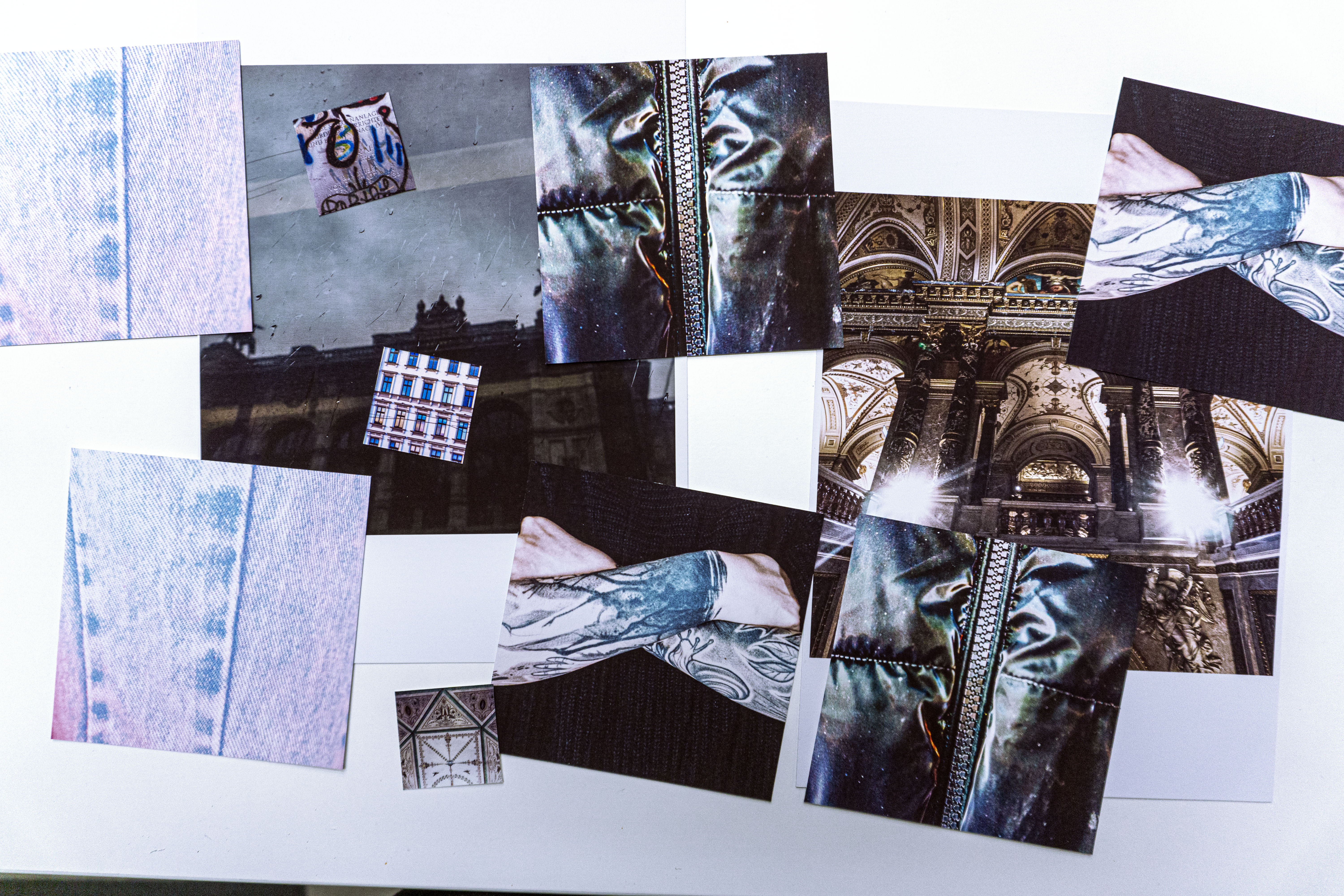
Contributions: Denim (Diana R. from Ukraine), tattoos (Leni V. from Vienna), jacket (Irem M. from Turkey)
Process:

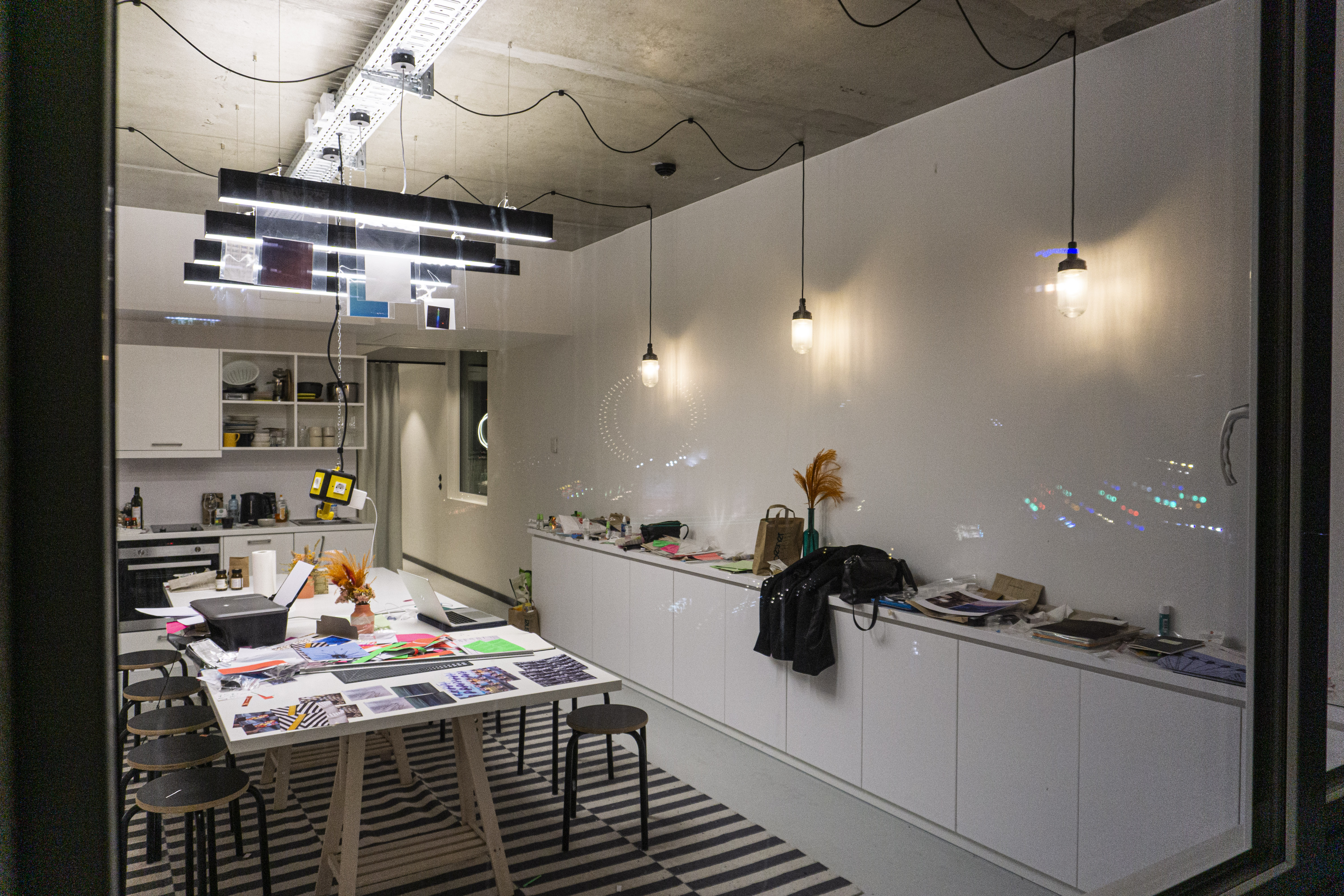

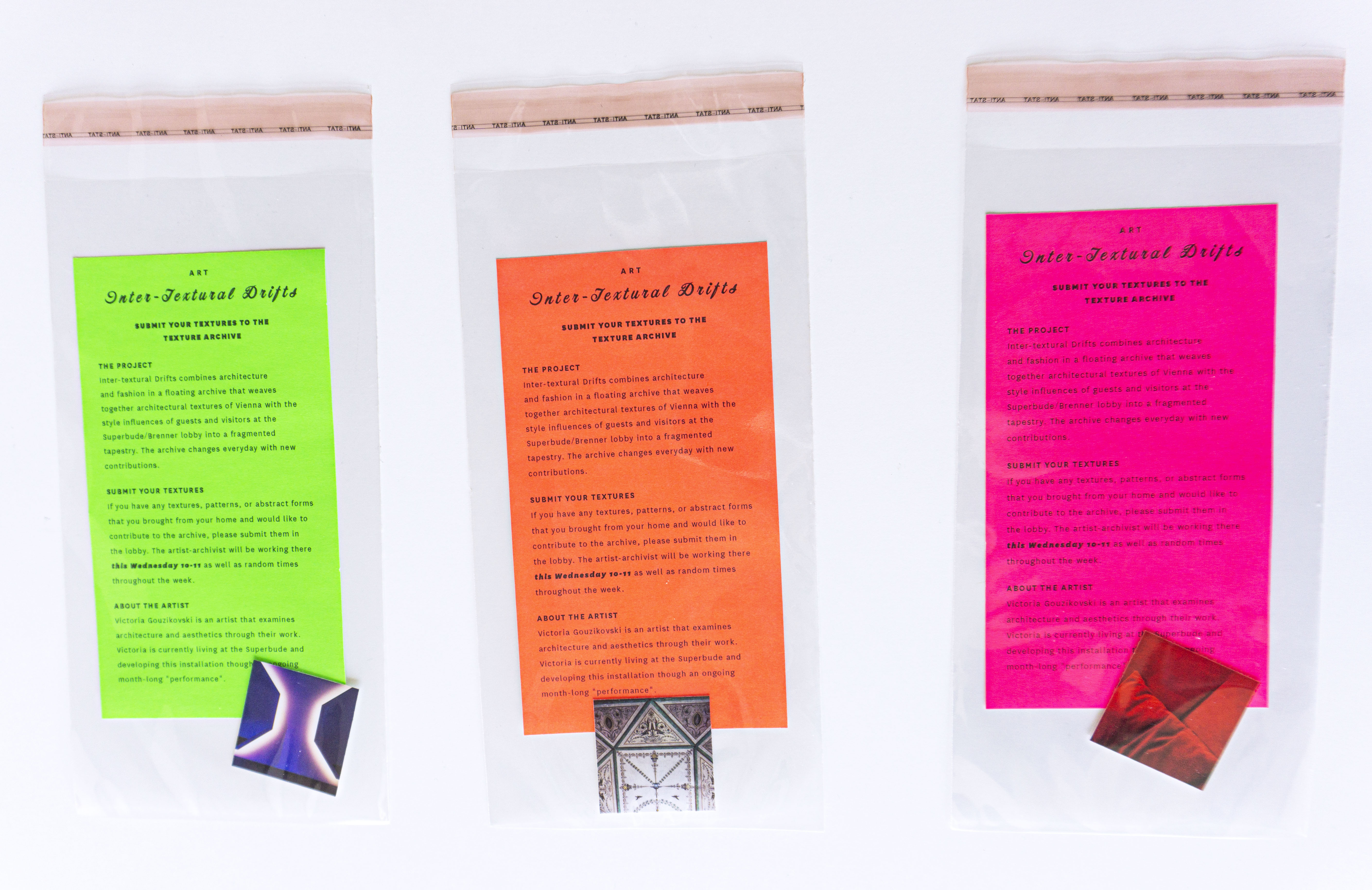

approach:
Inter-Textural drifts was an installation that sampled aesthetic influences of the city into an aerial archive. The project was both a durational performance and a participatory archive that evolved and changed throughout the month of April.
The work wove together textures from visitors at the Superbude Hotel with textures from the city of Vienna, forming a hybrid of fragmented “nomadic tapestry” and floating “aerial archive”.
During the month of April, the artist-archivist (myself) collected architectural textures from the city and added them to the archive every day, and then combined this with archival sessions in the Superbude/Brenner area, where I would photograph textures of visitor’s items, clothing, and sometimes bodies and other stylistic elements. (texture samples included handwriting, layered clothing and textiles, abstracted tattoos, occasionally it also included artwork made by the users themselves — for instance, the architectural drawings of an architecture student from Germany in the Brenner coffee shop, a powerful denim jacket drawing from a Ukranian guest taking refuge at the Superbude, and photographs of city textures others took on their phones (these photographic submissions were collected by photographing the contributor’s phone with the image on it). In these instances, the contributors’ authorship was retained and emphasized through the way these textures were presented and were noted in the installation map on the communal table under the installation.
The work wove together textures from visitors at the Superbude Hotel with textures from the city of Vienna, forming a hybrid of fragmented “nomadic tapestry” and floating “aerial archive”.
During the month of April, the artist-archivist (myself) collected architectural textures from the city and added them to the archive every day, and then combined this with archival sessions in the Superbude/Brenner area, where I would photograph textures of visitor’s items, clothing, and sometimes bodies and other stylistic elements. (texture samples included handwriting, layered clothing and textiles, abstracted tattoos, occasionally it also included artwork made by the users themselves — for instance, the architectural drawings of an architecture student from Germany in the Brenner coffee shop, a powerful denim jacket drawing from a Ukranian guest taking refuge at the Superbude, and photographs of city textures others took on their phones (these photographic submissions were collected by photographing the contributor’s phone with the image on it). In these instances, the contributors’ authorship was retained and emphasized through the way these textures were presented and were noted in the installation map on the communal table under the installation.
Urban textures focused mostly on buildings and the urban landscape, but ended up also sampling sections of famous paintings and artworks in Viennese museums. Through this interplay of personal and public textures, interesting connections were developed: stylistic connections between fashion and architecture were drawn: as more fashion became involved, the archive began to include clothing details form historic paintings (a closeup of one of Velasquez’s Infanta Margarita’s dresses), and architectural details from people’s accessories (an architectural plated backpack of a visitor getting coffee).
Many of the contributions were placed above the location they were collected above the common table. For example, I had curated an image of a visitor’s handwritten notes — he was planning a vacation while drinking coffee at the table — and the image of the handwriting is hung exactly above that spot above the table, an image of the curtain by the door hangs by the curtain by the door, and so on.
Many of the contributions were placed above the location they were collected above the common table. For example, I had curated an image of a visitor’s handwritten notes — he was planning a vacation while drinking coffee at the table — and the image of the handwriting is hung exactly above that spot above the table, an image of the curtain by the door hangs by the curtain by the door, and so on.
With its contextualization at a hotel, the installation also provided a sort of sensory “city guide”, and sometimes a sort of “finding game” about city experiences: well known artworks and iconic buildings were presented as abstractions and only vaguely hinted at in the installation map (for instance, a crop of Dan Flavin’s work was simply listed as “work in the Mumok”, easily identified, but only once the reader has visited the museum. These descriptions were less detailed than individual contributions because they are more of an “homage” where authorship of the represented piece is clear. A yellow curtain from my favorite Vienniese cafe (Café Sperl) is coyly referred to as “Cafe near Kettenbrückengaße”. A sample of Vienniese brocade on display was labeled as “Brocade for sale on Oper, Karlsplatz”. These descriptions were positioned to delight those who had been there and remembered those associations, and provide a slight challenge to be rewarded for those that wanted to experience them themselves — a subtle commentary on the commodification of experience but also an attempt to make these places discoverable by those who have a more expanded attention span, if anything, at least towards a less commercial, “slow-toursim”, if you will.
The interconnections within the archive also began forming some interpersonal connections as well: the process prompted new conversations and return visits — not necessarily the return visits that make monetary profit for a venue, but the kind that create social connections and cultural value arising form shared experiences and interconnected interactions.
The interconnections within the archive also began forming some interpersonal connections as well: the process prompted new conversations and return visits — not necessarily the return visits that make monetary profit for a venue, but the kind that create social connections and cultural value arising form shared experiences and interconnected interactions.
The archive also presented details from the Superbude hotel itself, some from the immediate surroundings of the archive (a lobby curtain, a tv display, a marquee), and sometimes from behind the scenes (aluminum covered pipes from the basement, parts of the hotel building from outside, views from the windows of the hotel, images from my own room), as well as a self-referential image of the installation itself during part of the process.
Affinities were found between various textures: the architectural backpack and the nearby university building, light denim pants (paired with pink shoes) of a stylish teenager from Ukraine taking refuge at the hotel paired with the pink sunset of the Prater, a polka-dot blouse of a visitor from Venice paired with a similarly-themed door of a French bakery (Parémi), the caramel-toned folds of a coat hanging in the cafe, with the pattern of a fence at an art auction house, colorful balloons from the Prater with a visitor’s t-shirt graphic saying “love is love” in rainbow colors, the tattoo sleeves of someone working at the Superbude one day with an abstracted projection of a video installation at the Mumok. -- disparate elements now inhabiting the same realm of associations.
Affinities were found between various textures: the architectural backpack and the nearby university building, light denim pants (paired with pink shoes) of a stylish teenager from Ukraine taking refuge at the hotel paired with the pink sunset of the Prater, a polka-dot blouse of a visitor from Venice paired with a similarly-themed door of a French bakery (Parémi), the caramel-toned folds of a coat hanging in the cafe, with the pattern of a fence at an art auction house, colorful balloons from the Prater with a visitor’s t-shirt graphic saying “love is love” in rainbow colors, the tattoo sleeves of someone working at the Superbude one day with an abstracted projection of a video installation at the Mumok. -- disparate elements now inhabiting the same realm of associations.
